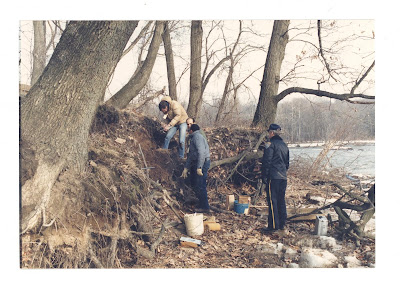Figure 1
The Monongahela were a Late
Prehistoric group of people who lived in the lower Upper Ohio Valley of southwestern
Pennsylvania from circa A.D. 1050 - A.D. 1615/35. Many of their settlements were
built on bluffs overlooking large river systems while others were hidden away
on low terraces adjacent to smaller waterways. The typical Monongahela village can
be described as a single or double ring of small round houses (domestic/storage/burial
zone). Many of the houses also had a semi-subterranean pit that was
free-standing or attached to the wall (Figure 1). Houses were built around an
open plaza (communal zone) encircled by one or more gated palisades (defensive
zone). An encircling ditch-trench, surrounding the palisade, was used as a convenient
place for discarding trash (disposal zone) (Figure 2). Most villages covered an
acre or more though some were enormous, approaching nine acres in size. Village locations were
re-used over time as is indicated by overlapping palisades and midden features
of accumulated trash at some sites (Figure 3).
Figure 2
Figure 3
During
the 15th century the internal composition of Monongahela villages changed
to include a single, larger-than-average, round house, a pattern that over time
appears to have moved toward the outermost ring of houses. This type of
structure was a place where some of the dead were interred, frequently exceeding
more than 10 individuals (Figure 4). These so-called charnel structures may
have been reserved principally for individuals, who were perhaps considered
prominent members of the community i.e. headmen or others serving special roles
or perhaps members of a certain lineage. There was, however, no general preference
as to the gender or age of the interred individuals. By the late 16th
century houses for the dead disappear from the archaeological record and infants
and children are the only classes of individuals being continually interred in the
common village household. Adult and elderly Monongahelans were evidently buried
elsewhere which marks a defining moment in Monongahela mortuary practices from
earlier times.
Figure 4
Curiously,
by the proto-Historic period circa A.D 1550/75 Monongahelans began building large
round-shaped buildings with semi-subterranean petal-shaped appendages at some
of their settlements (Figure 5). Petal structures, like the smaller size
Monongahela households had a centrally placed hearth where residents prepared
and processed food. At colder temperatures, the hearth became the sole source
of radiating heat both in households and petal structures. The archaeology at
these sites suggests that newer petal-structures were often rebuilt on or very
near the footprint of older ones thereby demonstrating a desire to reuse the
same general locations through time.
Figure 5
The number of appendages associated
with petal structures varied widely. For example, at Sony, Throckmorton and the
Foley Farm sites, archaeologists found as few as 11 to as many as 24 appendages
attached to petal structures. An opening or doorway always appears on the
northeast to southeast side of the petal structure. When petal structures were
first incorporated into the ring of houses, as at the Throckmorton site, the
doorway always faced toward the village plaza (Figure 6). The appendages associated
with houses and larger petal structures are recognizably different in that the latter
generally had a greater length ratio of nearly 2 to 1.
Figure 6
There is a long-standing assumption
by archaeologists that semi-subterranean structural features, whether free
standing or otherwise, were used for storage of perishable foods and, no doubt,
a resident’s personal effects. The function and purpose of Monongahela petal
structures may never be satisfactorily explained since their morphology is
generally comparable to Monongahela dwellings. That petal structures abruptly appear
in southwestern Pennsylvania at the very end of the Late Prehistoric period when
goods of the European trade begin to filter into the region from the eastern
coast of North America seems clear from the archaeological evidence. With these
changes in village architecture came disease, sickness and often death, to
people who had little resistance to biological vectors of calamity.
In summary, it is interesting to
note that Monongahela villages grew from small settlements containing a half
dozen or so houses to enormous settlements covering many acres followed by a
recognizable reduction in village size in the closing years of the Late
Prehistoric period with the appearance of petal structures and the
disappearance of charnel structures in the Monongahela core area of
southwestern Pennsylvania. These archaeologically deduced observations leave us
with many unanswered questions regarding the driving forces that forever changed
the settlement, community and mortuary patterns of a disappearing people called
Monongahela.
We hope you’ve enjoyed this glimpse
into the past at the Monongahela peoples who occupied Pennsylvania during
prehistoric times and invite you to visit other blogs on TWIPA which discuss
the Monongahela. Understanding and exploring
our archaeological heritage is pivotal to our understanding of human behavior
and our ability to change and adapt over time- just as the Monongahela peoples did
for hundreds of years.
References:
Davis, Christine E. and Amy K.
Wilks
1997 Phase
III Data Recovery Sony Site, 36WM151, Westmoreland County, Pennsylvania. A
Cultural Resource Management Report prepared for the Westmoreland County
Industrial Development Corporation.
Dragoo, Don
1955 Excavations at the Johnston Site. Pennsylvania Archaeologist 25(2): 86-141.
1983 The Gnagey Site and the Monongahela
Occupation of the Somerset Plateau. Pennsylvania
Archaeologist 53(4): 1-92.
Herbstritt,
James T.
2003 Foley Farm: The Importance of
Architecture and the Demise of the Monongahelans. Pennsylvania Archaeologist 73(1): 8-54.
Mayer-Oakes,
William J.
1955 Prehistory of the Upper Ohio Valley; An
Introductory Archaeological Study. Anthropological
Series No.2. Annals of the Carnegie Museum.
NPW Consultants,
Inc.
1983 Excavations
at Two Monongahela Sites: Late Woodland Gensler (36GR63) and Proto-Historic
Throckmorton (36GR160). Report submitted to Consolidation Coal Company,
Pittsburgh, Pennsylvania













